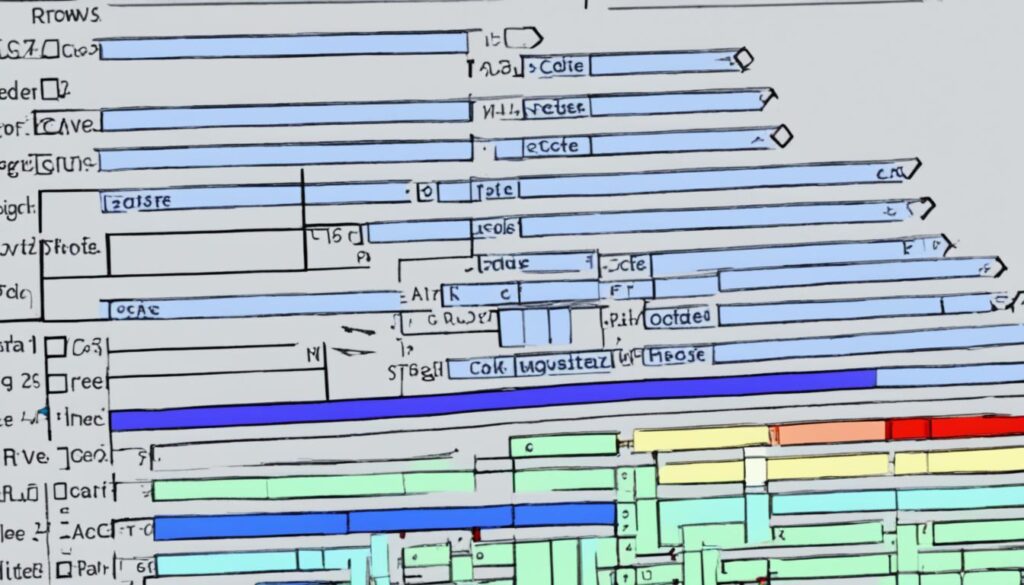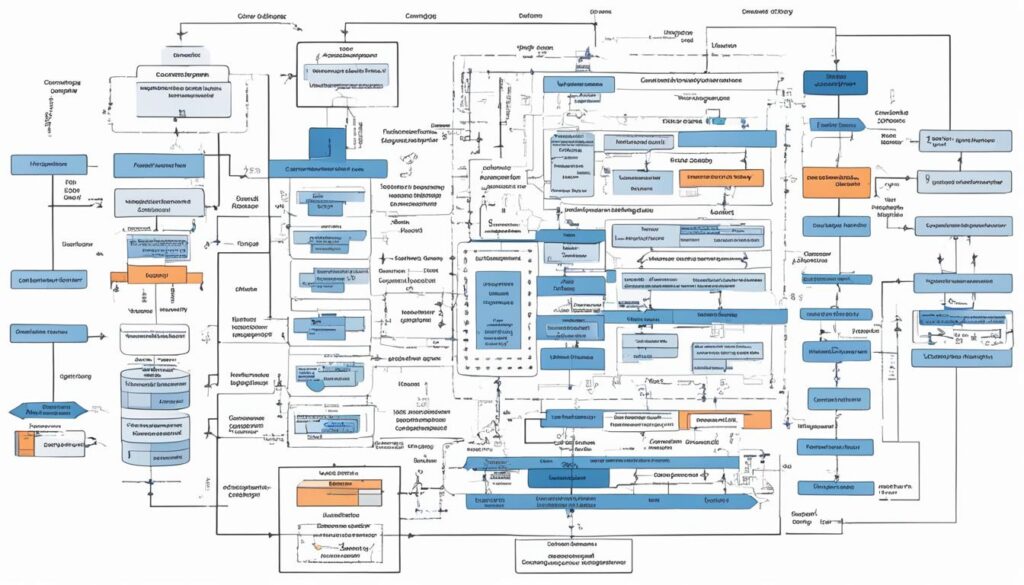Welcome to our comprehensive guide on Register Abstraction and Modeling in SystemVerilog (SV). In this article, we will explore the significance of register abstraction and modeling in the context of chip development, and how it optimizes the design verification process.
When it comes to chip development, Register Abstraction plays a crucial role in accurately representing the functionalities of the hardware. By abstracting the behavior of registers, designers can model their operations and interactions within the system, enabling efficient design verification.
SystemVerilog (SV) provides a powerful and flexible language for modeling registers. It offers a range of constructs and attributes that allow designers to define and manipulate registers effectively. With SV, the process of modeling registers becomes streamlined and efficient, contributing to improved chip development.
Through Register Modeling, designers can achieve various benefits in the design verification process. It enables efficient debugging and simplifies functional verification by providing a standardized way to represent and verify register operations. Additionally, register modeling enhances the overall productivity of chip development, contributing to the timely delivery of high-quality designs.
Our guide will also provide you with best practices and guidelines to effectively implement register abstraction and modeling in SV. By following these recommendations, you can ensure accurate and efficient register modeling, avoiding common mistakes and maximizing the benefits it offers in chip development.
Join us as we delve into the world of Register Abstraction and Modeling in SV, and discover how it can revolutionize your chip development process.
Table of Contents
Understanding Register Abstraction
In chip design, register abstraction plays a crucial role in optimizing the development process. By abstracting the functionality and behavior of registers, designers can simplify the complexity of chip design and improve overall efficiency. But what exactly is register abstraction, and how does it contribute to the success of chip development?
Register abstraction involves the representation of registers in a concise and high-level manner, focusing on their essential characteristics and operations. It allows designers to interact with registers at a more abstract level, shielding them from the intricacies of the underlying hardware implementation. This abstraction enables efficient chip design by providing a clear and intuitive interface for implementing register-based operations.
In chip design, registers serve as essential storage elements that hold data or control signals. They play a critical role in facilitating communication between various components of the chip and are involved in a wide range of operations, including data transfer, synchronization, and control. Register abstraction allows designers to define and utilize these registers in their designs without having to deal with the low-level details.
There are different types of registers used in chip design, each with its specific purpose and functionality. Some commonly used registers include:
- General-purpose registers: These registers are used for temporary storage of data during processing. They are versatile and can be used for various purposes based on the specific requirements of the design.
- Control registers: These registers control the behavior of different functional units in the chip. They are responsible for enabling or disabling specific features and configuring various parameters.
- Status registers: These registers provide information about the current state of the chip. They store flags, indicators, or error codes that can be read by software or other hardware components.
- Special-function registers: These registers are designed to perform specific functions, such as timers, counters, or communication interfaces. They have dedicated functionalities and are often accessed by specific instructions or protocols.
The operations performed on registers can vary depending on their type and purpose. Common register operations include:
- Read: This operation involves fetching the current value stored in a register for further processing or utilization.
- Write: This operation allows designers to overwrite the stored value in a register with new data.
- Clear: This operation resets the value of a register to a default or initial state.
- Set: This operation sets specific bits or flags in a register to indicate a particular state or configuration.
- Update: This operation modifies specific bits or fields within a register while preserving the remaining values.
Implementing register abstraction in the chip design process offers several benefits. It allows for better separation of concerns between the hardware and software development teams. Hardware designers can focus on the efficient implementation of registers, while software developers can interact with the registers using a well-defined and abstracted interface.
Furthermore, register abstraction promotes reusability and modularity in chip design. By encapsulating registers as abstract entities, they can be easily reused in multiple designs, reducing the effort required for design implementation and verification.
To illustrate the concept of register abstraction, let’s examine a simplified example of a control register in a hypothetical chip design:
| Register Name | Functionality |
|---|---|
| CTRL_REG | Controls the operation mode of a specific component in the chip |
| CTRL_REG[0] | Enable/Disable Feature A |
| CTRL_REG[1] | Enable/Disable Feature B |
| CTRL_REG[2] | Enable/Disable Feature C |
In this example, the CTRL_REG control register abstracts the behavior and configuration of a specific component. It provides three individual bits (CTRL_REG[0], CTRL_REG[1], and CTRL_REG[2]) that enable or disable specific features within the component. By interacting with the CTRL_REG register, designers can easily configure the behavior of the component without having to deal with the intricate details of its implementation.
Understanding the concept of register abstraction is essential for designers involved in chip development. It allows for a more streamlined design process, enhanced reusability, and improved collaboration between hardware and software teams. In the next section, we will explore the process of modeling registers in SystemVerilog, a hardware description language commonly used in chip design.
Modeling Registers in SystemVerilog
In the previous section, we explored the concept of register abstraction and its significance in chip design. Now, we will delve into the modeling of registers in SystemVerilog (SV), a hardware description language widely used in the semiconductor industry. By accurately modeling registers, designers can ensure the proper functioning and performance of their designs.

When modeling registers in SystemVerilog, it is essential to understand the syntax and constructs used to define them. Registers are typically defined using the reg keyword, followed by their size and name. For example:
reg [7:0] my_register;Here, we define a register named my_register with a size of 8 bits, indicated by the [7:0] notation. This allows us to store and manipulate values within the specified range of the register.
In addition to the basic definition, registers in SystemVerilog can have various attributes and properties that further enhance their functionality. These attributes include:
- Asynchronous or Synchronous: Registers can be designed to operate asynchronously or synchronized to a clock signal, depending on the design requirements.
- Reset and Initialization: Registers can be initialized to a specific value or reset to a default state, enabling predictable behavior during startup.
- Read and Write Operations: Registers can support read and write operations, allowing data to be stored and retrieved as needed.
- Interrupt Handling: Registers can be designed to handle interrupts and provide interrupt status information.
Furthermore, SystemVerilog offers different types of register models that cater to specific design requirements. Some commonly used register models include:
- Single-Port Register: This is the simplest form of a register, allowing access to a single data port.
- Dual-Port Register: Dual-port registers provide simultaneous read and write access through separate data ports, enabling efficient data transfer.
- FIFO Register: FIFO (First-In-First-Out) registers are used for implementing data buffers with a specific order of data retrieval.
- Memory-Mapped Register: Memory-mapped registers are designed to interface with external memory or peripheral components.
By selecting the appropriate register model and implementing the necessary attributes and properties, designers can create efficient and robust designs that meet their specific requirements.
| Register Type | Description |
|---|---|
| Single-Port Register | This basic register type provides access to a single data port. |
| Dual-Port Register | Dual-port registers allow simultaneous read and write access through separate data ports. |
| FIFO Register | FIFO registers are used for implementing data buffers with a specific order of data retrieval. |
| Memory-Mapped Register | Memory-mapped registers interface with external memory or peripheral components. |
Benefits of Register Modeling in SV
Register modeling plays a crucial role in the design verification process, offering several benefits that enhance the efficiency and productivity of chip development. In this section, we will explore these advantages and illustrate how they contribute to successful design verification.
1. Efficient Debugging
Register modeling provides designers with a powerful toolset to identify and resolve potential issues during the debugging phase. By accurately representing the behavior and functionality of registers, designers can simulate real-world scenarios and pinpoint any unforeseen errors or malfunctions. This efficient debugging process ensures a smoother chip development cycle and reduces time-to-market.
2. Simplified Functional Verification
When it comes to functional verification, register modeling simplifies the process by enabling designers to create comprehensive testbenches. Through register abstraction and modeling, designers can simulate and validate different operations and functionality, ensuring that the chip functions as expected under various conditions. This simplification of functional verification enhances the accuracy and reliability of the chip’s performance.
3. Improved Chip Development Productivity
Register modeling enhances productivity throughout the chip development process by providing designers with a clear representation of register behavior. This clarity enables efficient collaboration among design teams, accelerating the development cycle. Designers can easily understand and modify register behavior, facilitating seamless integration and reducing the risk of errors. The improved productivity ultimately leads to faster chip development and time-to-market.
4. Impact on Coverage Analysis and Testbench Development
Register modeling greatly impacts coverage analysis and testbench development. By accurately modeling registers, designers can track and measure the coverage achieved during verification. This analysis ensures that all important register properties and scenarios are thoroughly tested, improving the overall quality and reliability of the chip. Additionally, the availability of well-defined register models simplifies the creation of testbenches, enabling efficient verification and reducing the chance of missing critical scenarios.

In summary, the benefits of register modeling in design verification are significant. It enables efficient debugging, simplifies functional verification, improves chip development productivity, and impacts coverage analysis and testbench development. By leveraging register modeling techniques, designers can optimize their design verification process and deliver high-quality chips with confidence.
Best Practices for Register Abstraction and Modeling
When it comes to implementing register abstraction and modeling in SystemVerilog, following best practices is essential for achieving optimal results. By adhering to the guidelines outlined below, you can ensure accurate and efficient register modeling that aligns with industry standards.
Naming Conventions
Consistent and descriptive naming conventions play a crucial role in register abstraction and modeling. When defining registers, use concise yet meaningful names that accurately represent their purpose and functionality. Avoid ambiguous or generic names that could lead to confusion during the design and verification process.
Documentation
Comprehensive and well-documented register abstraction and modeling are vital for maintaining a clear understanding of the design. Document the intended behavior, attributes, and properties of each register in detail. This documentation will serve as a valuable resource for both the design team and future users, facilitating easier integration and troubleshooting.
Reusability
Designing register models with reusability in mind can significantly enhance efficiency and productivity. By creating modular and reusable register abstractions, you can save time and effort when reusing existing designs for new projects. This approach also ensures consistency across designs, minimizes errors, and promotes scalability.
Common Mistakes to Avoid
While implementing register abstraction and modeling, it is crucial to be aware of common mistakes that can hinder the effectiveness of your design. Some common pitfalls include:
- Using inconsistent or unclear naming conventions
- Overcomplicating register models with unnecessary details
- Neglecting comprehensive documentation
- Not considering reusability during the design process
By actively avoiding these mistakes, you can maintain the integrity and efficiency of your register abstraction and modeling practices.
Enhancement Techniques
To further improve the accuracy and efficiency of register modeling, consider implementing the following techniques:
- Utilize proper data encapsulation for registers
- Implement well-defined register initialization and reset mechanisms
- Use appropriate data types and bit-level operations for efficient modeling
- Ensure proper synchronization and clock-domain crossing techniques
By incorporating these techniques into your register modeling approach, you can optimize the performance and reliability of your designs.
Remember, following best practices and guidelines for register abstraction and modeling in SystemVerilog is key to maximizing the benefits and efficiency of your design verification process. By incorporating proper naming conventions, comprehensive documentation, reusability, and avoiding common mistakes, you can create accurate and efficient register models that meet the highest industry standards.
Conclusion
In conclusion, this article has provided a comprehensive overview of Register Abstraction and Modeling in SV. We have explored its significance in chip development, the process of modeling registers in SystemVerilog, and the benefits it offers in design verification.
By implementing best practices and guidelines, designers can optimize the use of register abstraction and modeling to ensure a robust and efficient chip development process. Register abstraction allows for the representation of complex hardware structures in a simplified and manageable way, enabling easier debugging and functional verification.
Furthermore, modeling registers in SystemVerilog provides designers with a powerful language that offers flexibility and scalability. This enables designers to accurately define the behavior and properties of registers, ensuring accurate simulation and analysis.
Overall, register abstraction and modeling in SV play a vital role in chip development, enhancing the efficiency of design verification and ultimately contributing to the successful development of high-quality semiconductor chips.

